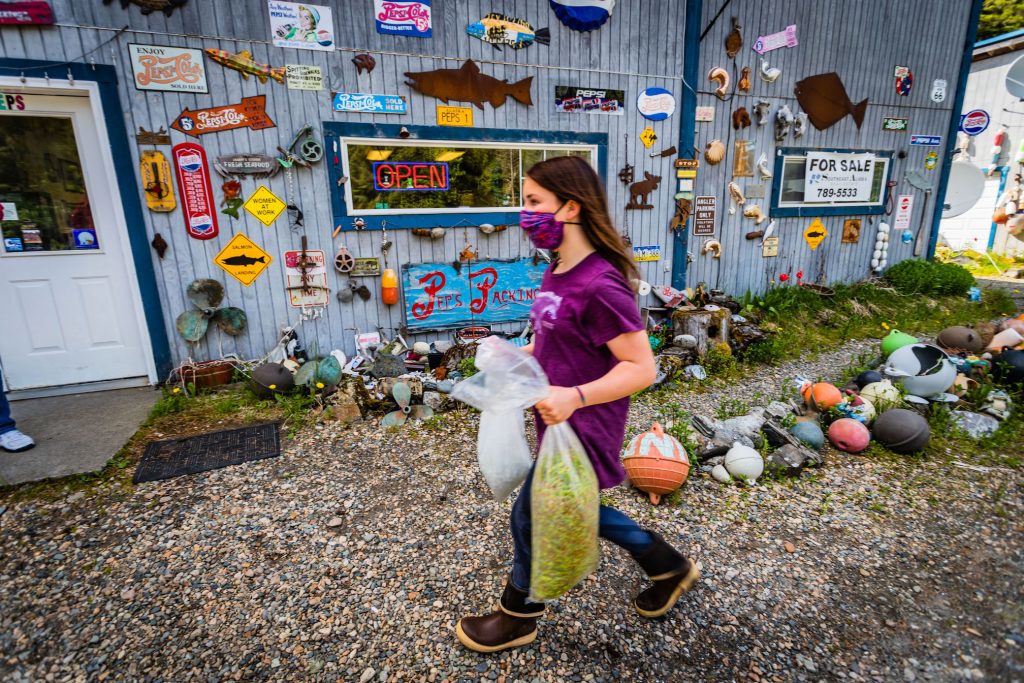These days, nearly everything in our food and beverage industry is mechanized. However, you might be glad to learn that there is still at least one ingredient that can’t be harvested by a machine, and it just happens to be growing on trees — spruce tips.
Every spring, during a brief 10-day window, the Sitka spruce trees in southeast Alaska bring forth their new growth in the form of vibrantly lush, green, and aromatic tips. These tips, long prized for their unique flavor, are harvested in a fast and frenzied gathering binge that temporarily dominates the culture of the small town of Gustavus, where spruce trees are abundant.
Spruce tips have been harvested in the region for a variety of uses. The Tlingit people utilized spruce (shéiyi) trees for myriad reasons, including the tips in a tea for an early season source of vitamin C. Captain James Cook used them in a drink for the same reason. Southeast Alaskans have long gathered the tips, adding water and sugar to cook them down into a sweet syrup to be enjoyed on pancakes. Today, commercial demand for spruce tips has exploded as breweries incorporate the tips into high-end alcoholic beverages seeking a unique flavor that is described as being simultaneously lemony, berry-like, tart, and piney.
Making money
The timing of the gathering coincides nicely with the end of school in late May, with spruce tip picking offering many kids their first opportunity to earn money. Each spring, a target amount of tips is set, and once that level is reached, all picking comes to an end.
While kids do much of the picking, for many it is a family affair. The teenagers are often out on their own, but younger children, trying to be like their older siblings, go picking alongside their parents and grandparents.

At the end of each day, pickers gather their bounty and head over to Pep’s Packing, the local fish packer, to have their tips weighed, accounted for, and prepped for freezing and shipping. Pep Scott, the proprietor, explained, “Some kids were in diapers when they first started picking, and now they are out there with their own kids picking. The whole family goes out and picks all day. We have little kids who might bring in half a pound, all the way up to 80-year-olds that bring in 100 pounds a day.
And at $3 per pound, that adds up. One Gustavian took his earnings to Mexico to get his dental work done. Another youngster bought a lawn mower to launch his summer lawn mowing business. Some kids just buy candy, but with dozens of pickers gathering thousands of pounds of spruce tips, this tradition provides a much-needed economic boost right before the busy summer tourist season that drives the local economy.
While this is a family-friendly activity, leave it to Alaskans to turn it into a contest. Pep told me, “It’s a very friendly competition but there’s a lot of competition between families, and individuals. They always want to know who picked what.” This past year one of the most ardent, long-time pickers finally got out-picked by his grandson, which caused quite a stir. Pep often passes out prizes to kids who put in extra effort or bring in the most tips on any given day.
Spruce tips in beer and balm
Once the spruce tips are harvested, they are frozen and shipped out. The lion’s share of the product goes to the Alaskan Brewing Company in Juneau. Originally, they used the tips in making a specialty beer. The “Spruce IPA” is the winner of six medals and the brewery attributes its unique flavor to Gustavus’s quality key ingredient. More recently, the company has been using the tips to create hard seltzers, which have taken off in popularity. According to Andy Kline, Alaskan Brewing spokesperson, “The place where we really figured out that using spruce tips would be exciting is in our seltzer. So now all of our hard seltzers have spruce tips as a base. And that’s what really separates our seltzers from all of the others that are coming on to market.”

Not all of the tips are going into beverages, however. One of Gustavus’s local entrepreneurs incorporates spruce tips into one of her wild-crafted skin care products. Brittney Cannamore owns and operates Wren and Raven Botanicals and uses spruce tips to make her “Forest Balm” salve which offers “relief from cuts, bruises, rashes, inflammation, and sore or strained muscles.”
A win-win
Despite the fast-paced industrialized craziness that is the modern world, an annual tradition of spruce tip picking in Gustavus creates a space in which good old-fashioned hard work and homespun family life persist. Pep’s husband, John, said, “I’ve had a lot of parents tell me how much they appreciate the fact that the kids are actually learning. You go out, you work hard, you make money and then you have money to spend on stuff. It’s a hard lesson to teach kids nowadays in the computer age when most kids want to sit around and play computer games—to actually get kids outside working and being taught a work ethic.”
Spruce tip picking is a win-win for Gustavians—they get a fun activity to share outside with their kids, and they get paid for it. While the Gustavus economy is mainly driven by tourism, for at least one week a year, spruce tips take the lead—the money is, literally, growing on trees.


Comments are closed.